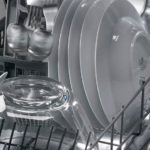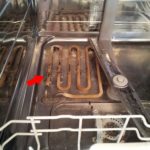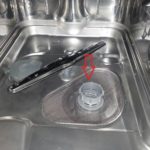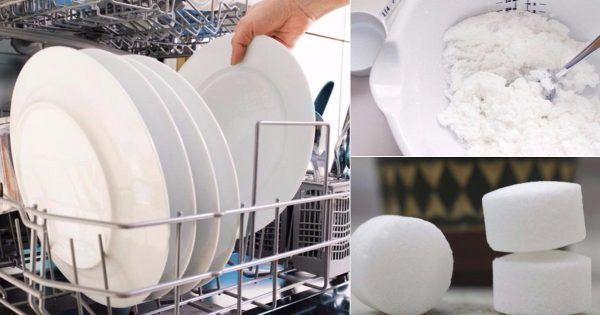Why doesn't the dishwasher dry the dishes?
After washing the dishes, the machine proceeds to drying them. The quality of drying determines what the dishes will look like after the end of the cycle - dry, beautiful, shiny, or wet, with drops and stains that you can’t even put on the table. You have to pick up a towel and do the work yourself.
If drying occurs according to the second scenario, this may be a signal that the dishwasher is malfunctioning. Types of malfunctions associated with poor drying will be discussed within the framework of this article.
The content of the article
Types of dishwasher dryers (condenser drying, turbo drying)
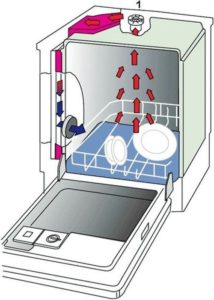 Condensation, or natural drying occurs when the dishes gradually cool down after rinsing them with hot water. The steam from the dishes condenses on the walls of the chamber, after which the drops flow into the container. The advantage is the cost-effectiveness of the method, the disadvantage is a very long drying time; some housewives, for example, start the machine in the evening so that the dishes are properly dry by the morning. An option to get rid of condensation on dishes is to open the dishwasher door.
Condensation, or natural drying occurs when the dishes gradually cool down after rinsing them with hot water. The steam from the dishes condenses on the walls of the chamber, after which the drops flow into the container. The advantage is the cost-effectiveness of the method, the disadvantage is a very long drying time; some housewives, for example, start the machine in the evening so that the dishes are properly dry by the morning. An option to get rid of condensation on dishes is to open the dishwasher door.
Turbo drying, or as it is also called, convection, is carried out by supplying hot air using a fan. The advantage of the method is speed, but to implement it, a heating element must work, consuming a significant amount of electricity. Some owners resort to a trick - they turn off the machine after the last rinse cycle and open the door slightly.
Troubleshooting a Convection Dry Dishwasher
How to check the serviceability of the heating element and fix the breakdown
 Heating elements cannot be repaired independently; they need to be replaced. Its serviceability is checked using a multimeter; the heating element is located at the bottom of the dishwasher. To remove it, you need to remove the bottom of the car. After this, the performance of the heating element is checked and, if necessary, replaced, preferably with the same one.
Heating elements cannot be repaired independently; they need to be replaced. Its serviceability is checked using a multimeter; the heating element is located at the bottom of the dishwasher. To remove it, you need to remove the bottom of the car. After this, the performance of the heating element is checked and, if necessary, replaced, preferably with the same one.
How to check the functionality of the temperature sensor and troubleshoot the problem
The temperature sensor is located in the opening of the water collection chamber. In working condition, it controls the water temperature and sends a command to dry the dishes on the heating element. If it malfunctions, the drying process does not start due to the lack of a command to the heating element. To replace the sensor, remove the wires from it, then take it out, after which a new device is connected. Upon completion, the PMM is tested for performance.
How to troubleshoot if a fan or relay is broken
 The relay is usually located on the control board located inside the door. To remove it, unscrew the bolts and remove the cover on the inside of the door. If you have the skill to use a soldering iron, you can re-solder the relay yourself. If you have doubts about success, do not doubt it - call a specialist, he will do everything.The fan will have to be replaced, since it cannot be repaired. A sign of fan failure is the absence of sound when the turbo dryer is running.
The relay is usually located on the control board located inside the door. To remove it, unscrew the bolts and remove the cover on the inside of the door. If you have the skill to use a soldering iron, you can re-solder the relay yourself. If you have doubts about success, do not doubt it - call a specialist, he will do everything.The fan will have to be replaced, since it cannot be repaired. A sign of fan failure is the absence of sound when the turbo dryer is running.
The location of the fan is different for different models - on the side wall, at the bottom or at the top of the chamber. Getting to the fan is not easy; you will have to disassemble almost the entire machine.
Troubleshooting a Condenser Dry Dishwasher
The main malfunctions in PMMs of this type are:
- failure of the heating element - the water does not heat up, the dishes therefore do not wash or dry. The heating element is replaced in the same way as for dishwashers with turbo drying;
- temperature sensor malfunction - replace in the same way as described above;
- relay failure on the control board. We also considered this malfunction; everything is done in the same way as with PMM with turbo drying.

